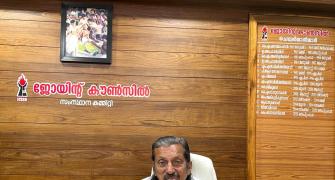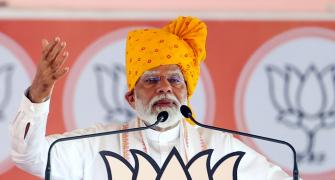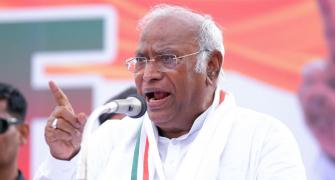The numbers are bewitching. Media analysts say over 210 million people across the world will be watching TV on mobile devices by 2011. Even better, Asia-Pacific will lead the way in mobile TV growth with more than 95 million subscribers in the region by 2011.
So, what will change in these four years for Indian subscribers? For starters, mobile TV (or streaming of live television on to mobile phones) will grow out of its infancy and overcome its numerous technical and legal hurdles. More importantly, broadcasters, mobile carriers and device manufacturers will start making money.
Going for the kill first, Doordarshan has announced it will beam eight channels on to digital video broadcasting-handheld (DVB-H) compliant mobile handsets, signalling the start of commercial mobile TV services in India. Carriers like Reliance, eager to boost mobile data usage and declining voice average user revenues per subscriber, have also launched video streaming for subscribers.
Vineet Taneja, director (multimedia) for Nokia says, "There will be some teething troubles involving service disruption and inability to receive signals but at least we have made a beginning."
Research firm Informa believes that 50.97 million DVB-H devices will be sold globally by 2010. In anticipation, Nokia has announced the launch of its N92, priced somewhat steeply at Rs 25,000, and will release another handset, the N77, this year.
"Nokia," insists Taneja, "is working closely in delivering free-to-air channels from Doordarshan to private broadcasters."
With the Indian mobile phone market expected to breach the 348 million mark by 2010, luring a growing mobile population towards data-rich applications like mobile TV seems to be on everybody's agenda.
The immediate problem, though, appears to be easing the availability of cheaper handsets and of broadcast for mobile broadcast TV.
Doordarshan's present bouquet of channels is nothing to boast about. If the "upwardly mobile" population is what players like Nokia are looking at, then channels like DD National, DD News, DD Sports, DD Bharati, DD Urdu, DD Punjabi, DD Bangla and DD Podhigai really don't cut ice, even if they come free. Private broadcasters may hope for rights to beam a few channels, but until then consumers have to be content with DD.
"The current bouquet on Reliance includes channels like Aaj Tak, CNN International, NDTV 24x7, CNN Awaaz, CNBC TV18, CNN-IBN, IBN7, Times Now, Sun TV and Asianet," says Krishna Durbha, head, marketing applications solutions and content group, Reliance Communications.
Bharti Telesoft, the software arm of Bharti, claims to have broken the glass ceiling with its GPRS-based Live TV that can work on any mobile phone that can play videos. The primary difference between Live TV and mobile broadcast TV is that the former broadcasts channels after a 30-second delay.
"A GPRS-enabled handset needs to install a TV client (a short download) and allow users to select content from its media gallery," explains Ramesh Krishnan, director (content solutions),
Bharti Telesoft.
Bharti Telesoft is working with Tata Indicom and Bharti to launch Live TV services in India. "By September, you will see the first commercial launch from Bharti Telesoft," he confirms.
Also, working with with channels like CNN-IBN among other news channels, Krishnan feels, "Live TV content has to be suitable for snacking to accommodate consumers' limited attention span as well as the limited life of the mobile battery."
"Snackable" content is not expected to be watched from beginning to end, agrees Taneja, "You get to grab a quick bite, and if you're interrupted, it's no big deal. But the bottomline is that the quality of video content streamed has to be as good as on a PC."
Going by the Informa report, by 2010 the mobile data market will be be a $10-billion (Rs 43,000-crore (Rs billion)) market in India, and live video streaming or mobile TV promises to be a good chunk of it. The business model, however, between mobile operators and broadcasters, remains obscure, as does the issue of who will regulate mobile TV services.
Niraj Roy, CEO, Hungama Mobile, who claims to be providing content in six countries, says, "We have the rights to almost 70 per cent of the Bollywood content and in the next six months the Indian market will be ready for mobile films and other video content."
In a subscription-based model, the players speculate that monthly charges could vary between Rs 50-90, depending upon the data downloaded, while in a pay-per-view format it could cost anywhere between Rs 25 and Rs 40 per clip. Reliance is also planning to launch Mobile Theatre, where the mobile becomes a multiplex showing full length movies and users can choose which show to pay for and watch.
Mobile TV presents huge opportunities for broadcasters, advertisers, operators and content providers in terms of increasing average revenue per user and adding value to consumer experiences.
"Advertising on mobile TV will have to suit itself to the snacking culture of mobile TV viewing," adds Krishnan. Advertisers are currently experimenting with 5-7 second advertising slots and, like broadcasters, will have to develop new production techniques which are adapted to the small screen, Roy finishes.
A new lexicon for a new format
Talking heads and close-ups: To fit the screen size, broadcasters will need to focus on talking heads, where viewers will be able to watch close-ups and see the details, rather than capturing a wide screen.
Snackable content: Mobile TV content will need to be suitable for 'snacking' or bit viewing.
Mobisodes: Fragmented and small made-for-mobile episodes that cater to bite-sized portions of content on the go.
Visual spectacle: Programmes will need to emphasise visual spectacle over conventional narrative and be image-oriented.
Source: Key findings from London School of Economics Mobile TV report








